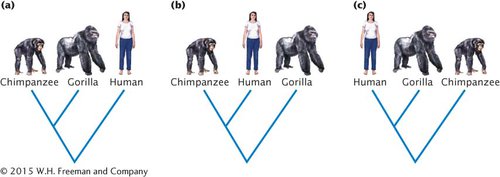The Construction of Phylogenetic Trees
Consider a simple phylogeny that depicts the evolutionary relationships among three organisms: humans, chimpanzees, and gorillas. Charles Darwin originally proposed that chimpanzees and gorillas were closely related to humans, and modern research supports a close relationship between these three species. There are three possible phylogenetic trees for humans, chimpanzees, and gorillas (Figure 18.16). The goal of the evolutionary biologist is to determine which of the trees is correct. Molecular data applied to this question strongly suggest a close relationship between humans and chimpanzees (as shown in Figure 18.16b).

There are different approaches to inferring evolutionary relationships and constructing phylogenetic trees. In one approach, termed the distance approach, evolutionary relationships are inferred on the basis of the overall degree of similarity between organisms. Typically, a number of different phenotypic characteristics or gene sequences are examined, and the organisms are grouped on the basis of their overall similarity, considering all the examined characteristics and sequences. Another approach, called the parsimony approach, infers phylogenetic relationships on the basis of the minimum number of evolutionary changes that must have taken place since the organisms last had an ancestor in common. With both the distance and the parsimony approaches, a number of different numerical methods are available for the construction of phylogenetic trees. All include certain assumptions that help limit the number of different trees that must be considered; most rely on computer programs that compare phenotypic characteristics or sequence data to sequentially group organisms in the construction of the tree. Other methods for constructing phylogenetic trees have been developed that incorporate models of how evolution occurs.
CONCEPTS
Molecular data can be used to infer phylogenies of groups of living organisms. Two approaches to reconstructing a phylogeny are the distance approach, which uses the overall degree of similarity between organisms, and the parsimony approach, which uses the minimum number of evolutionary steps required to connect the organisms.